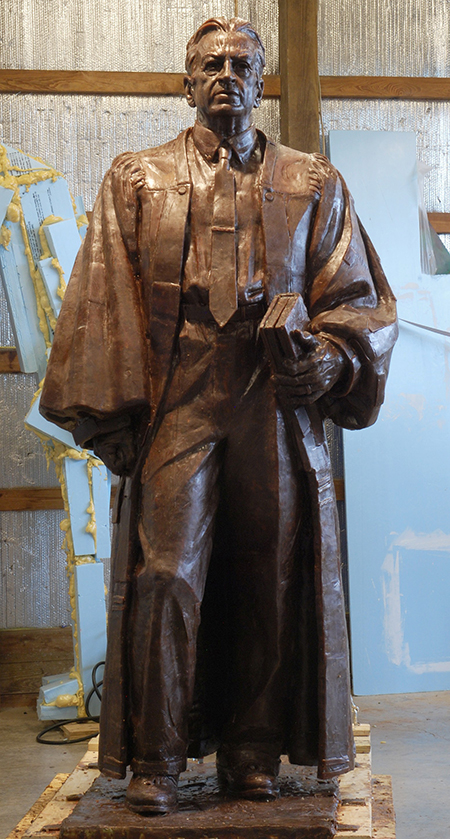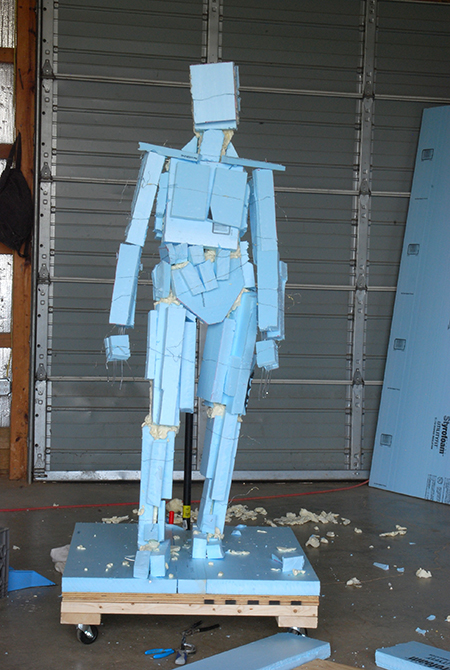In 2011, U.S. District Judge Richard Gergel and S.C. Supreme Court Chief Justice Jean Toal held a symposium in Charleston to mark the 50th anniversary of the Briggs v. Elliott ruling. This ruling led to the creation of a committee that raised about $125,000 to commission a statue to honor U.S. District Judge J. Waties Waring; the man whose anti-segregation rulings made him a pariah in his hometown, but set the table for the Civil Rights Movement.
In “‘A liberating force,’ Waring returns to Charleston” Post and Courier journalist Robert Behre writes that a dozen sculptors sought to create the bronze likeness of Waring, and Rick Weaver, a sculptor from Charlottesville, Va., won the commission. Mr. Weaver was kind enough to take the time to answer questions about his work and to describe the process of creating this important sculpture. Mr. Weaver will join artist Jonathan Green and Dr. Jeb Hallett on March 10 for a panel discussion on The Art of Social Healing Through Sculpture and Public Art at the Charleston Federal Courthouse on Broad Street.

How did you originally get interested and trained in sculpture?
I actually received my training not in sculpture, but in drawing and painting in New York, and then received my graduate degree in painting at UNC-Greensboro. Whether you are working in charcoal, paint, clay, or any other medium, the underlying principles in art do not vary. So when I became more interested in sculpture, I was able to essentially teach myself the procedure. I gradually moved my focus to sculpture in the last 10 years because the ideas I wanted to express seemed to have ultimately more to do with creating a shape in space, and depended less on creating an illusion on a 2 dimensional surface.
Describe the process of how you got to know Waties Waring in order to design your statue of him?
I first read the biography “A Passion for Justice” to get a feel for the man and his accomplishments. It was also very helpful to speak with members of the sculpture committee, who had a familiarity with his judicial and social history in Charleston. Ultimately, I feel I can only really know myself – I never feel that I can truly understand another person in any comprehensive way, and I therefore never feel capable of “capturing” someone else in a sculpture. What I do is try to identify some vital aspect of someone’s character that I also recognize in myself, and then try to make the sculpture about that emotion or idea. With Judge Waring, I identified very closely with the idea that he was embattled, and pressured to do things he knew were wrong. Yet he persevered in his own beliefs of what was right and was true to his nature, despite the condemnation of his peers. (Not that I equate his courage with anything I possess, but I think there is some modest echo of what he displayed in all of us). Most good sculptures ultimately rise above the individual depicted, his or her gender, race, and personal history, and touch on themes that are universal and felt by all humanity. To what degree I was successful in this attempt is for others to judge, but that was my goal with the Judge Waring sculpture.
Just how does one make a statue of this magnitude? Briefly describe the manufacturing process.
On the manufacturing end, I will say that very early on, for the reasons given above, it was clear the statue should be in a standing position, to show Judge Waring’s resolute physical stance as a powerful metaphor for the intellectual stance he took in his judicial decisions. I worked on a life-size scale in my studio, beginning with a foam and aluminum armature, and progressing to a wax modeling of the actual figure. I have included images which may illustrate the process better than my words. This final sculpture was then put in the capable hands of Carolina Bronze Foundry who completed all casting processes necessary to convert my wax sculpture into the final bronze.

Did this project in any way impact your own personal feelings about the Civil Rights Movement and the sacrifice of champions like Judge Waring?
My knowledge of American History, let alone the Civil Rights Movement, is not what it should be. So I am always very thankful for the excuse to research historical figures to fill in the gaps of my early education. I always feel that if my initial schooling had centered on integrating academic subjects with art I would have retained a lot more information. In reading about Civil Rights heroes like Judge Waring, John Chavis, or Maggie Walker, I am struck by their relentless courage in the face of opposition. The example of fortitude in mere mortals, however elevated by history, makes that kind of courage more accessible to me in some way that I may not have felt if I had not read their histories.
Related articles:
A liberating force,’ Waring returns to Charleston by Robert Behre, Post and Courier
Judge J. Waties Waring: Charleston’s Insider Agitator by Robert Rosen, Post and Courier
Judge Remembered For Landmark Role He Played In Desegregating Schools by Bruce Smith, Huffington Post
Rick Weaver received his formal training in New York at the National Academy of Design, the New York Academy, and the Art Students League. He earned his Master of Fine Arts from the University of North Carolina-Greensboro, where he was influenced by the sculptor Billy Lee.
Jonathan Green’s painting “Breath of Freedom,” depicts a crowd of people outside the Charleston federal courthouse listening to the trial Briggs vs. Elliot. He donated a copy of this painting to every public high school in the Charleston County school district. Green’s painting was presented at the Hollings Judicial Center Garden on April 11, 2014, the same day as the Judge Waties Warning sculpture dedication.
This event is at full capacity but you can learn more about our Art of Healing series by signing up for our e-newsletter, following us on Facebook, Twitter, or Instagram, and checking our online calendar.
Thank you to Dr. Jeb Hallett who formulated the questions for Mr. Weaver and who will be moderating Tuesday night’s panel discussion. The Art of Healing is sponsored by Roper St. Francis.
Published March 3, 2015

